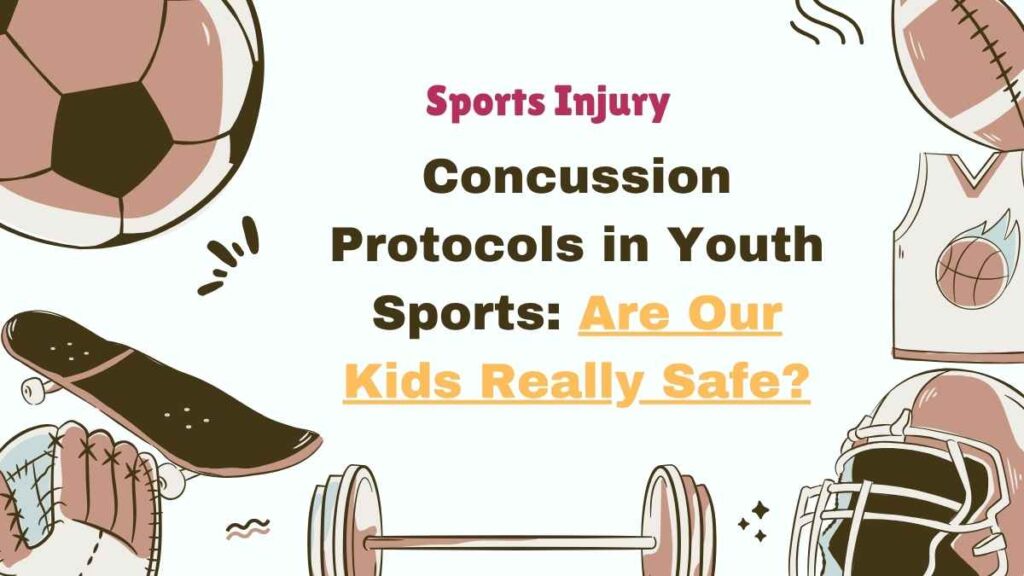Table of Contents
Concussion Protocols in Youth Sports
Every parent wants their child to thrive in sports—chasing dreams on the soccer field, basketball court, or hockey rink. But with the thrill of competition comes a hidden risk: concussions. These brain injuries, often dismissed as “just a bump,” can have lasting consequences, especially for young athletes whose brains are still developing. As discussions on platforms like X highlight growing concerns, it’s time to ask: are current concussion protocols in youth sports truly keeping our kids safe? Let’s dive into the latest updates, practical steps for parents and coaches, and cutting-edge advancements in concussion detection.
Understanding Concussions: More Than Just a Headache
A concussion is a mild traumatic brain injury caused by a blow or jolt to the head, disrupting normal brain function. In youth sports, concussions are alarmingly common—studies estimate that up to 3.8 million sports-related concussions occur annually in the U.S. alone. Symptoms like dizziness, confusion, or nausea can appear immediately or develop over hours, making early detection tricky. For kids, whose brains are more vulnerable, repeated or mismanaged concussions can lead to long-term issues, including memory problems or even chronic traumatic encephalopathy (CTE), a degenerative brain disease linked to repeated head trauma.
Recent conversations on X reflect parents’ and coaches’ fears about these risks, with many calling for better education and stricter protocols. The good news? Sports organizations are stepping up, but there’s still work to be done.
New Guidelines: What’s Changed in Concussion Management?
Over the past few years, youth sports organizations have overhauled concussion protocols to prioritize safety. The latest guidelines, endorsed by groups like the CDC and the American Academy of Pediatrics, emphasize three key phases: diagnosis, recovery, and return-to-play.
- Diagnosis: Coaches and trainers are now trained to use standardized tools like the Sport Concussion Assessment Tool (SCAT5) to spot concussions on the field. Symptoms like balance issues or difficulty concentrating trigger immediate removal from play—no exceptions.
- Recovery: Rest is critical, but it’s not just about sitting in a dark room anymore. Updated protocols recommend a balance of physical and cognitive rest, followed by a gradual return to activities like schoolwork. Most kids recover within 7-10 days, but some may need weeks.
- Return-to-Play: Athletes must complete a step-by-step process, progressing from light exercise to full-contact practice, only after being cleared by a medical professional. This ensures the brain is fully healed before facing new risks.
These updates aim to reduce the “play through it” mentality, but enforcement varies. Some youth leagues lack the resources to train coaches or access medical experts, leaving gaps in safety.
Empowering Parents and Coaches: How to Stay Informed
Parents and coaches are the first line of defense against concussion risks. Here’s how you can protect young athletes:
- Know the Signs: Look for symptoms like headaches, irritability, or trouble focusing. Kids may not always report feeling “off,” so watch for changes in behavior or performance.
- Get Educated: Free resources like the CDC’s HEADS UP program offer training on concussion recognition and response. Share these with your team’s coaches and parents.
- Advocate for Safety: Push for baseline testing, which measures an athlete’s cognitive function before the season. If a concussion occurs, doctors can compare post-injury results to gauge recovery.
- Ask Questions: If your child’s league doesn’t have a clear concussion policy, speak up. Ask about training for coaches and access to athletic trainers.
On X, parents are sharing stories of advocating for better protocols, with some leagues now mandating annual concussion training for coaches. These grassroots efforts are making a difference, but consistency across all youth sports remains a challenge.
Cutting-Edge Concussion Detection: Technology to the Rescue
Technology is transforming how we detect and manage concussions, offering hope for safer sports. Recent advancements include:
- Impact Sensors: Helmets and mouthguards with built-in sensors, like those from Riddell or X2 Biosystems, measure the force of hits in real-time. Coaches receive alerts if a player sustains a potentially dangerous impact.
- Portable Neurotech: Devices like the EyeBOX, a non-invasive tool that tracks eye movements to diagnose concussions, are gaining traction. These can be used on the sidelines for faster, more accurate assessments.
- AI-Powered Analysis: Artificial intelligence is helping doctors analyze brain scans and predict recovery timelines. Some apps even guide athletes through recovery with personalized plans.
While these tools are promising, they’re not yet standard in youth sports due to cost. X users have voiced frustration over this, with some calling for subsidies to make tech accessible to all teams, not just elite programs.
The Road Ahead: Building a Safer Future for Young Athletes
Concussion protocols have come a long way, but gaps remain. Uneven enforcement, lack of resources, and varying awareness levels mean some kids are still at risk. Parents and coaches must stay proactive—learning the signs, demanding clear policies, and embracing new technologies. By working together, we can ensure that youth sports remain a place for growth and fun, not hidden dangers.
Want to make a difference? Share your thoughts on concussion safety in your local leagues, and check out resources like the CDC’s HEADS UP or Concussion Legacy Foundation for tools to keep kids safe. Let’s keep the conversation going and protect the next generation of athletes.

